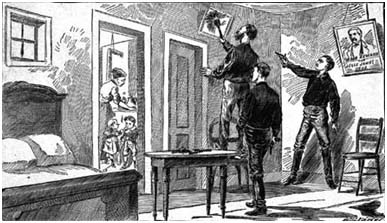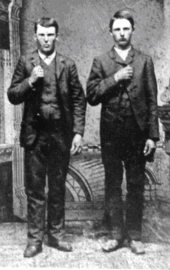On April 3, 1882 the infamous Jesse
James met his end at the hands of “fellow gang member Bob Ford, who betrayed
James for reward money” (Jesse James Is Murdered). The wanted dead or alive
criminal, notorious for robberies within banks and trains, was shot in the back
attempting to adjust a picture frame while his mother made breakfast. Although
it is widely accepted that James was murdered on that day, some believe it was
all a hoax in order to throw off those who had been pursuing him for years and
years. This essay will examine the two largely discussed possibilities of
James’ death:
1. He was murdered by Bob Ford one of
his own gang
2. He faked his death and continued his
life elsewhere under a different name
It will compare and contrast all available facts and
probabilities in order to provide an unbiased, informative reading.
Jesse
Woodson James, born on September 5, 1847, was the most notorious bank and train
robber in the West, and his name has now become attributed to crime
itself. It is believed that Jesse and
his brother, Frank, turned to a life of crime to escape the “harsh postwar
civil legislation” imposed by the North (Jesse James Biography). “From 1860 to 1882, the James Gang was the
most feared band of outlaws in American history,” guilty of numerous accounts
of theft and murder, granting Jesse the moniker of the most notorious bank and
train robber in the West (2). Jesse’s
gang became synonymous with crime by involving themselves in “more than 20 bank
and train robberies … [of] an estimated $200,000,” and the slaughter of
“countless individuals who stood in their way” (2).
Jesse did not care about the lives
of others when they stepped in his way.
Jesse’s history involved a myriad of crimes which was mostly defined by
robbery, but before he became the leader of his own band of criminals Jesse had
to prove he was not all talk. Jesse
began his life of crime under the leadership of William “Bloody Bill” Anderson and learned his
brutal ways by emulating the pro-Confederate guerrilla. Under Anderson’s authority, “the guerrillas,”
including James, “shot [a] line of 22 unarmed Union soldiers … [at] What became
known as the Centralia Massacre” (Wolnisty).
About one month after the event at Centralia, Anderson was drawn “into
an ambush near the village of Albany,” where he met his end (Biography: William "Bloody Bill" Anderson). Jesse was furious at the loss of his mentor
and in “the 1869 Gallatin bank robbery… James’ desire [was] to kill Samuel Cox
and thereby avenge Bloody Bill’s death” (4).
Not only does Jesse kill out of
revenge, but he will also kill anyone who threatens his success in a robbery
whether they are armed or not is of no consequence to him. In April, 1872, Jesse’s group robbed a bank
in Kentucky, but when the “cashier refused to open the bank vault … the lead
bank robber,” Jesse, “shot him down,” to show that James did not put it above
himself to do what he ordered (Jesse
James' Bank Robberies). Jesse and Frank were involved in many atrocious
crimes and their actions cannot be commended, but it is evident that Jesse
proved himself to be an effective leader.
Jesse organized many robberies and commanded a small band of outlaws
with his brother.
One such robbery in Croydon, Iowa,
featured the gang “arriving during a speech … that had drawn most of the town
to the local Methodist church” while the James Gang ended up unscathed with
$6,000 from the local bank (5). Up until
1876, the group had been very successful, and Jesse had earned a tremendous
bounty on his head. But, the gang soon
fell apart during a robbery in Northfield, Minnesota, when “citizens outside
[the bank] had noticed the outlaws and began arriving with guns” which lead to
the death and/or capture of several of its members (5).
This did not make Jesse shy away
from leadership. In fact, he began again
and recruited many others, including Robert and Charles Ford. “On April 3 … Bob and Charlie [Ford] drew
their weapons, and Bob put a bullet in the back of Jesse’s brain,” but, instead
of being seen as a no-good bandit who got what he deserved, he was revered as
the legendary figure of the Wild West and the most successful gang leader of
the time period (The Death of
Jesse James).
On the outside, Jesse Woodson James
was an effective leader. Underneath this
exterior lies a vicious, cold-hearted, murderer. The fact that Jesse maintained his gang of
outlaws, defined him as an incredible leader.
Though he was believed to be dead at the hand of Robert Ford, there is a
slight chance that the ruthless and cunning, legend of the Wild West lived on
by successfully faking his own death.
There are
only two conspiracy theories worth discussing surrounding the death of,
notorious outlaw, Jesse James. The first
theory is that Jesse James was murdered by Robert Ford on April 3, 1882. The other theory claims that Jesse’s death
was only a ploy in order to throw the law off his trail so that he could live a
peaceful life with his family.
The first
theory, that Jesse met his end in 1882, is highly debated among those that want
to know the truth about one of Hollywood’s favorite outlaws. Due to a study conducted by forensic
scientist, James E. Starrs, in 1995, new evidence has been provided to support
the claim “that [Jesse] really did die in 1882 and not 1951” (Where Jesse James Was Killed, St. Joseph, Missouri). Starrs’ survey of Jesse’s supposed grave in
Kearney, Missouri shows that “DNA extracted from a tooth found in the grave
proved with 99.7 percent certainty … that it was Jesse” (7). Other than the DNA tests, there was also the
fact that the skull found in the Missouri grave had a bullet hole in the back
of it, but this alone is not enough proof for conspiracy theorists to
believe. The skull display accompanied
by “Jesse’s stubby teeth, many with gold fillings (A sign suggests that he
ground them nervously),” proves that the body buried in the grave had been put
under much stress over the years and that the owner was wealthy enough to treat
his teeth accordingly (7). It is evident
that Jesse James was put under an immense amount of stress during his life
pursued by the law and that he accumulated enough wealth to fill his teeth, so
it can be deduced that Jesse was the body found dead in 1882.
The second
conspiracy theory suggests that Jesse James never died in 1882 and that the
whole incident was just a way to throw the law off his back. The biggest instigator of doubt surrounding
Jesse James’ death happened “In the early 1900’s … J. Frank Dalton traveled
from town to town and claimed to be the real Jesse James” (The Truth about Jesse James). If this J. Frank Dalton is who he claims to
be then that would raise the question; “Who is buried in Missouri, if not Jesse
James” (8)? The only logical reason that
Jesse could have shown up in Granbury, Texas, years after his own funeral was
that, after numerous failed attempts, he had finally succeeded in faking his
own death.
After fifteen
years of following the trail of Jesse James, Bud Hardcastle, a Jesse James
historian, has gathered information from many sources to shed light on the
controversial subject. According to
Hardcastle, it is safe to assume that “a man named Charlie Bigelow was really
the person buried in Missouri” (The Truth about Jesse James). At the time, Bigelow had been “using Jesse’s
name,” to commit robberies all across Missouri and when authorities finally
caught up to him they believed that James had finally been brought to justice
and buried Bigelow in his place (8). To
further Hardcastle’s claim that Jesse lived on, Hardcastle quoted an old
newspaper in which “the doctor who examined the body told Jesse’s son that the
corpse was not that of Jesse James because Jesse James had … cataracts,” but
the corpse had no eye problems (8).
Many who believe
in the first theory often refer to the DNA test conducted in 1995 by James E.
Starrs. Starrs lead an exhumation
project of the corpse in Jesse’s grave and the corpse of his mother Zerelda
James Samuel. “Mitochondrial DNA … was
to be chosen for that exhumation” so that Starr could find out if the DNA in
Jesse’s grave matched that of his mother (Evidence - DNA). However, instead of exhuming Jesse’s mother,
“the perfect candidate for a DNA reference sample, he chose Robert A. Jackson
and his nephew Mark Nikkel,” which only served to belittle the test results due
to the fact that Jesse and his nephews were more distant genetically than he
and his mother (9).
After conducting
a survey to see which theory people believe, 42 out of 50 people believe that
Jesse did not fake his own death and that his body lies in the grave outside
his home in Kearney, Missouri. Although
most accept the idea that Jesse died in Missouri, it is worth noting that there
is more evidence to support the theory that Jesse faked his own death rather
than actually meeting his end.
Jesse James’
official death is recorded as murder at the hands of Robert Ford on April 3,
1882. However, the legendary outlaw’s
death has, to this day, never been proven as fact. The only two possibilities are:
1. He was murdered
by Robert Ford one of his own gang
2. He faked his own
death and continued his life elsewhere under a different name
Evidence is provided for both conspiracy
theories, but, the bulk of the information on Jesse’s death makes it hard to
believe that the cold-hearted, crime lord died that day in April.



Works Cited:
"Jesse James
Biography." Bio.com. A&E
Networks Television, n.d. Web. 19 Oct. 2016.
"Biography:
William "Bloody Bill" Anderson." PBS. PBS, n.d. Web. 30 Oct. 2016.
Wolnisty, Claire. "Centralia Massacre" Civil War
on the Western Border: The
Missouri-Kansas Conflict, 1854-1865. The Kansas City Public
Library. Accessed Nov, 15, 2016 at http://www.civilwaronthewesternborder.org/encyclopedia/centralia-massacre
"Jesse
James' Bank Robberies." PBS.
PBS, n.d. Web. 15 Nov. 2016.
"The
Death of Jesse James." PBS. PBS,
n.d. Web. 15 Nov. 2016.
“Jesse James Is Murdered.” History.com, A&E Television
Networks,
Kirby, Doug, Ken Smith, and Mike Wilkins. "Where Jesse
James Was Killed, St. Joseph,
Missouri."RoadsideAmerica.com. RoadsideAmerica.com,
n.d. Web. 25 Nov. 2016.
"The Truth about Jesse James." The Truth about
Jesse James. Durangotexas.com, n.d.
Web. 25 Nov. 2016.
"Evidence - DNA." Jesse James' Death Hoax and
Buried Treasures. N.p., n.d. Web. 25
Nov. 2016.

No comments:
Post a Comment